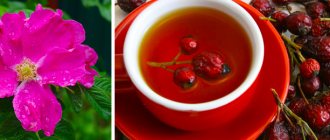Rose is rightly called the queen of flowers.
And the royal personage came from a modest and inconspicuous-looking rosehip. This is a very ancient plant; imprints of its leaves are found in fossilized rocks. Man began to use the bush long ago as medicine, a vitamin product, and as decoration. It was planted around the perimeter of the site so that the thorny bushes would protect it from wild animals. Birds, various rodents and amphibians love to feast on rose hips. By eating the berries, they contribute to the spread of the plant, because Rosehip seeds are not digested and end up in the soil along with excrement. In such small animals as fox, hare, field mice, berries serve as an indispensable vitamin food in winter.
Origin and distribution area
It is believed that the birthplace of rose hips is the Himalayas and the rocky part of Iran. But today, thanks to their unpretentiousness and winter hardiness, its various species have spread widely across all continents, except the Arctic.
The most favorable growing conditions are the Mediterranean. But from the Arctic Circle to the Equator, on both American continents, in Australia and New Zealand, rose hips of various types are found everywhere. In mountainous areas it grows at an altitude of 2000 - 2200 m, and in more southern, tropical countries, it can grow at around 4 thousand m above sea level.
Bush forms of rose hips grow singly or in small groups. It is found on the edges of forests of all types, where there is a lot of sun. It grows well in undergrowth, as well as on the banks of lakes, rivers, along the outskirts of meadow lands, and on the sea coast. He likes to settle in dry ravines and sparse forests. There are species that form dense thickets in steppe and forest-steppe areas and can even inhabit deserts.
Contraindications
Are there situations or reasons why the use of rose hips is contraindicated? Although the fruits themselves are beneficial for the daily diet, and the vitamin C they contain is essential for the proper functioning of the body, there are reasons to refrain from using rose hips.
A balanced and nutritious diet that covers the body's daily requirement for ascorbic acid does not require additional support. Then the use of additional supplements can be harmful to health, leading to hypervitaminosis, the results of which include diarrhea, abdominal pain, nausea, and skin rashes.
People with high acidity of the gastrointestinal tract should use rosehip decoctions, infusions and other drugs with caution.
Consult a physician before use during pregnancy and breastfeeding.
Characteristic features of the bush
Rosehip is a perennial shrub; botanists classify it as a member of the Rosaceae genus. The shrub plant grows from 1 to 3 m. In the northern regions, the leaves fall off for the winter, and in the southern regions evergreen forms are found.
The branches usually have curved or straight thorns and numerous straight spines. Flowering shoots usually lack thorns.
In general, thorns are a distinctive feature of this plant, which gave it its name. They appeared as a result of evolutionary changes and the protection of rose hips from being eaten by mammals and herbivores. In turn, some of the animals managed to adapt to eating branches with thorns. For example, camels and many ruminants can easily cope with this.
Rose hips have flowers whose size ranges from 3 to 8 cm. The flowers usually have five petals on a small stalk with narrow, lanceolate bracts. When the berries ripen, depending on the type, the flowers either remain on the ripened fruit or fall off. Rosehip petals are colored in shades of red, pink, purple, and white. They grow solitary or collected in small inflorescences. Some varieties have very fragrant inflorescences, but occasionally they are completely odorless.
The bushes bloom in May, some species until July. Flowering occurs on two-year-old branches. Rosehip roots are very long, growing to a depth of 2-3 m. They are used as medicinal raw materials, as well as for preparing decoctions and infusions.
Topic of the day: The health benefits and harms of sea buckthorn. There are more vitamins than in rose hips!
"Titanium"
The bush is tall, erect, powerful. Branches up to 2 m long. Flowers pale pink. The fruits are large. Collected in clusters of 3-5 berries. The taste is sweet and sour. Productivity 1 kg per adult bush. Properties: Blooms profusely and beautifully from mid-August. Tolerates low temperatures well and is resistant to fungal and bacterial infections. Ripens in October. Suitable for designer garden decoration.
Varieties and varieties
Botanists have counted approximately four hundred species of this plant. Many varieties have also been bred that are significantly superior to wild forms in terms of yield, fruit size, and the content of medicinal substances in them. Let's consider the varietal diversity and varieties of shrubs that are most popular in our country.
globe
Powerful shrub with strong, arched shrubs. thick branches. The average height reaches 1.5 m. The flowers are large, pink, the edges of the petals are darker in color. The bright red berries are round, weighing 2-4 g, with an increased content of vit. C. The yield of the variety is considered quite high. The bushes tolerate severe frosts well. The variety belongs to the technical varieties; it is grown by mechanization. The berries are mainly used to make jam and candied fruits.
Vitamin VNIVI
Classified as an early variety, the bush is quite tall (up to 2 m). It has inflorescences consisting of medium-sized light pink flowers that do not self-pollinate. To get a high yield, you need to plant another type of rose hip nearby. The fruits are reddish-orange in color. The variety is winter-hardy, rarely damaged by harmful insects and diseases.
Vorontsovsky 1
Tall (up to 2.5 m) mid-season variety. It was obtained by crossing Webb's rose and wrinkled rose. The berries are round, slightly elongated, and reddish-orange in color. In fruits there is an increased presence of vit. C and folic acid. Up to 3 kg of berries are harvested from one bush. Winter hardiness is low; cover with spruce branches is required.
Rose Webb
A low shrub 1-2 m. Flowers (4-5 cm in diameter) are collected in corymbose inflorescences of 4-7 pieces, but are also found in single flowers. The petals are white or pinkish-white with a lilac or fawn tint; you can find pink with a white center. Fleshy berries are round in shape, scarlet in color. The vitamin C content in fruits is high. The plant is unpretentious, frost-resistant, and is grown in many gardens.
Rose wrinkled
This is one of the most famous and most planted types of rose hips; it grows in one place for 20 to 25 years.
Anti-aging pruning is required every 5 years. The bush is medium-sized, up to 1.5 m tall, with well-developed twisting branches, along the entire length of which small brush-like thorns grow.
The leaves are dark green, quite dense and strongly wrinkled. In autumn, the foliage turns a spectacular lemon yellow color. The inflorescences are found in white, red, pinkish or deep purple. The flowers are large, up to 8 cm, fragrant. Flowering begins in May and ends in early September, because... This type of rosehip is remontant. Consequently, fruiting is extended and continues until the end of October, when the first frosts begin. But most of the harvest is harvested during September. The yield is high - about 3-4 kg per bush.
The fruits are fleshy, red with an orange tint, large - up to 4 cm in diameter, slightly flattened at the tops. The berries are used for drying and making preserves and jam.
This species should not be propagated by seeds, because grown seedlings differ from the mother plant in all respects for the worse, this especially affects the yield. Therefore, when propagating, other methods are used - layering, cuttings, rhizome suckers, etc.
Anniversary
A medium-sized shrub, up to 1.5 m high, with powerful, strong branches. According to the ripening period, it belongs to the middle varieties. It almost does not form root shoots, so it is often used by gardeners for planting as a hedge. It looks simply amazing - in the spring it is covered with beautiful white-pink inflorescences, and in the fall - with red-orange berries rich in vitamin. C. Large round fruits are easily removed from the branches by dry tearing off, which is very convenient when harvesting and storing the crop. Not afraid of severe frosts. The berries are used for jam and drying.
Oval
This is a low, compact rose hip, grows up to 1.5 m. It is classified as a mid-season variety; its harvest begins to ripen in mid-August. The flowers are small, white, and during flowering they densely cover the branches. The fruits are juicy and sweetish in taste, with thick skin. The berries are suitable for drying and for processing into jam or compotes. The shape of the fruit is slightly flattened at the poles and has a rich bright red color. The variety is resistant to frost, does not get sick and is not afraid of harmful insects.
Apple
High-yielding low-growing variety, height no more than 1.2 m. The berries ripen early. The flowers are dark red, collected in inflorescences of 5-7 pieces. The fruits ripen in mid-August. The berries are large, onion-shaped, dark red in color. The taste of the fruits is sweet and sour, without cloying, suitable for drying, making compote, jam. Dried berries make a delicious vitamin tea. The bush is not damaged even in very frosty winters.
Ruby
A tall early variety, the height of individual specimens can reach 2.5-3 m. The shoots are powerful, erect, strewn with light thorns from top to bottom. It has small pinkish flowers. The fruits are not very large, round in shape, with a refreshing sweet and sour taste and high vitamin content. C. At first the berries are orange, then they turn dark red. Perfect for drying. Ruby is a frost-resistant variety.
Dog rose
This type of rosehip has a powerful and spreading bush, growing up to 3 m in height. Its branches bend in the form of an arc, sometimes reaching to the ground. Their color is green or red-brown. The branches rarely have large, hook-shaped, brown thorns.
Flowers with a diameter of up to 5-8 cm, the color of the petals is white, bright pink. The flowers are located one at a time on the shoots or collected in inflorescences of 3-5 pieces, and are odorless. The bush blooms in late May or early June.
Large shiny fruits up to 2.5 cm in length, bright red with an orange tint and ovoid in shape. Ripening begins in August. The berries of this variety contain less vitamin C than other varieties. Dog rose is often planted as a rootstock for roses, as well as for the production of the medicinal product “Holosas”.
This rose hip is unpretentious, frost-resistant, and almost not affected by harmful insects and diseases.
Rose cinnamon
This rose hip is a medium-sized plant, with a bush height of up to 2 m. Thin red-brown branches are sparsely covered with curved light-colored thorns, and in the lower part the bush is covered with multiple thorns.
Large flowers are 5-7 cm in diameter, pinkish or red in color, located singly on shoots or in inflorescences of 2-3 pieces. The bush blooms from May 15 to July 15 on shoots of the second year of life. The smooth berries have the shape of an ellipse, ball or egg, and are covered with orange or red skin. The yield from each bush is average, up to 2-3 kg.
Rose of Daurskaya
This rose hip is a representative of low-growing plants, up to 1.5 m tall. Distribution area: Mongolia, Far East, Baikal region. Along the entire length of the shoot, in addition to the flower branches, there are medium-sized, slightly curved thorns. Pink or dark pink flowers are not very large, up to 4 cm in diameter, in inflorescences of 2-3 pieces or solitary. The berries are also small, 1-1.5 cm long, dark red in color, spherical and slightly elongated in shape. The plant is frost-resistant, tolerates heat, but does not like drought.
Alpine rose
The low-growing bush has a height of about 1 m. Its habitat is the Alps mountains. It differs from all other rose hips in that there are no thorns on the shoots. The fruits are dark red in color, the shape of the berry is similar to a spindle, and on the branches in the fall they look like earrings.
French rose
A low-growing shrub, does not grow even to 1 m; its few shoots are densely covered with thorns and small thorns. Sometimes it forms impenetrable thickets. Inflorescences with large flowers, bright red in color. This rose hip has spread to the European part of our country, Ukraine, and southern Europe.
Apple rose
Tall shrub, up to 3 m in height. Rosehip got its name from its large berries, which are similar in size, shape and appearance to wild apples. When fully ripe they are yellow in color with ruddy barrels. Contents vit. C average.
Rose needle
This species is represented by a shrub 2-2.5 m tall. Its shoots are completely covered with thin, sharp, needle-like thorns. The flowers are small, pink, lilac-pink, and white. The berries have different shapes: round, elliptical, pear-shaped, oblong.
Rusty red rose
The shrub is of medium height, the shoots are straight or curved and densely strewn with thorns and thorns. Bright pink flowers are collected in inflorescences of several pieces. The berries are reddish in color with an orange tint. The shoots smell strongly of ripening apples, which is a special feature of this species.
Femoral-leaved (thorny) rose
This is a popular and widespread variety of rosehip. A shrub with spreading shoots, they are decorated with small leaves and soft yellow or white flowers that have a pleasant aroma. Flowering is abundant, but not longer than three weeks. But their fruits are painted black. The height of the bush varies from one to two meters.
The femoral rose has one interesting feature. If it is planted on the site, it is almost impossible to get rid of it in the future. The shrub scatters its underground shoots at considerable distances from the mother bush. A tiny piece of root continues to sprout. Therefore, this variety of rose hips is planted in places where there is no need to worry about its rapid and widespread spread. It is worth noting that the variety is frost-resistant and unpretentious; it will withstand the whole summer without watering. The variety is often planted to strengthen slopes.
We recommend studying: is it possible to grow oregano in your dacha?
Reviews from gardeners
Natalya, 49 years old, Ekaterinburg
Rose Grutendorst has been growing with me for 7 years. The flowers are very unusual, like real carnations with petals painted in a rich crimson color. I don’t get sick from anything, I don’t protect from frost. True, the shoots freeze to the level of the snow cover, but then quickly grow back. Sometimes the plant is attacked by aphids, so I do preventive treatments from time to time. The rose looks very elegant and requires almost no care.
Sofia, 37 years old, St. Petersburg
The most unpretentious rose in our dacha is the Queen of the North. We planted the bush three years ago. Now the height is almost one and a half meters, it winters well without shelter, blooms all summer and autumn until frost. The bush is harmonious, lush, elegant - all in bright crimson double flowers. The whole season pleases with its beauty and pleasant fruity smell.
Nadezhda, 58 years old, Tomsk region
I consider Rosa Hansaland one of the best in my garden. Very hardy, unpretentious, winters well, does not get sick, the foliage is healthy and beautiful, and blooms magnificently - the whole bush is strewn with armfuls of red flowers. There are more than 10 buds in one inflorescence. I recommend this variety to everyone, as it requires almost no maintenance, but looks very bright and impressive.
Growing, planting and care
Rosehip has an important distinctive quality: it is able to produce new shoots every year. This characteristic of the crop allows the above-ground part of the bush to be restored in a short time, even when it has been severely damaged or died.
It is preferable to plant rose hips on fertile and moist soils, because the plant is a heat-loving and light-loving crop. The shrub has a low need for winter “hibernation”. And when there are long thaws, and then cold weather again, the rosehip may freeze during the spring frosts.
The formation of new flower buds occurs on shoots two or three years old. It is these branches that have the least winter hardiness.
To make it easier to care for rosehip seedlings, they are placed in an area where there is a flat surface or a gentle slope without depressions. It is good when the slope is directed to the south or southwest. Floodplains of rivers with nutritious soil and an increased content of phosphorus and humus are suitable for placing rose hips. Planting areas should not be subject to prolonged flooding. Rosehip is a moisture-loving crop. A high fruit yield can only be obtained by regularly providing the plant with soil moisture.
The root stem of the rosehip goes deep into the ground, so it is not planted in marshy soils, otherwise it will quickly wither.
The roots of the bush grow quickly in the upper layers of the soil and occupy vast areas. To prevent this from happening, the bushes are fenced with a ditch up to 30 cm deep or pieces of slate are dug in.
Preparing for landing
They begin preparing the soil six months before planting the seedlings. During this time, the area must be dug up, fertilized in advance with humus at the rate of 10 kg per 1 m². Until autumn, the bed is kept loose and free from weeds.
Planting holes are dug in the fall. The depth of the hole is 30 cm, the width is half a meter. 1 kg of rotted compost or manure is added to each pit. The distance between the holes is 1 meter, the row spacing must be at least 3 meters.
Planting seedlings
Before planting rose hips, the root system of the seedling is dipped in a solution of water, clay and humus. This mixture will protect the roots from drying out. Young rose hips are pruned so that the length of thick shoots is up to 10 cm. The roots of the seedling are shortened to 20 cm.
Landing:
- Prepare the soil for planting the seedling. Garden soil is mixed with 10 kg of organic matter, add 3 tbsp. l. superphosphate, 2 tbsp. l. potassium sulfate and 2 tbsp. l. urea.
- Seedlings are placed in the holes and the roots are sprinkled with the prepared substrate, compacting it slightly.
- Water it with water. When it is absorbed into the ground, sprinkle the seedling with nutritious soil. The root collar should be almost at the surface of the soil.
- After planting, the seedling is watered and mulch (sawdust, peat) is added.
The best time to plant rose hips is in the fall. But planting is carried out both in spring and summer. Only the planting rules are slightly different from the autumn ones.
To pollinate rose hips, two or three different varieties are planted.
During the growing season, rosehip seedlings are watered, fertilized, and young shoots are removed along with weeds. Adult bushes undergo sanitary (pruning of old, broken branches) and regular pruning. The photo shows pruning in the fall:
For better growth and fruiting, foliar (leaf) and root feeding is carried out.
Fertilizer is applied to the roots before and after rosehip flowering. And also after completing the berry picking. One of the root dressings: dilute 1 tbsp in 10 liters of water. l. nitrophoska and urea, 3 tbsp. l. "Effectona" (for berry plants). 10–12 liters are used per bush.
The second root feeding is done after flowering. Feeding composition: dilute 2 tbsp in 10 liters of water. l. “Potassium humate” and 3 tbsp. l. "Effectona-2". Up to 15 liters of mixture are used for one bush.
The third time they feed with this composition: dissolve 2 tbsp in 10 liters of water. l. superphosphate and 1 tbsp. l. potassium sulfate. One bush is watered with 10 liters of solution.
To increase the quantity and quality of the crop, foliar feeding is performed. They are carried out after the rose hips bloom. Composition of the solution: dissolve 2 tbsp in 10 liters of water. l. "Potassium humate."
"Apple"
The bush is low, erect, spreading. Branches up to 1.5 m long, completely covered with thin and straight thorns. The leaf blades are large, gray-blue, pubescent on the inside. The flowers are large, dark red. The fruits are large, up to 12 g in weight, up to 3 cm in diameter; round, slightly flattened, similar to apples. The taste is sweet and sour. When choosing a rosehip seedling for planting on a summer cottage, gardeners are guided, first of all, by the expected result. Are you trying to get a complete medicinal product? Choose from a group of rosehips intended for medicinal use. Are you dreaming of a highlight that will decorate your garden? Choose a plant that blooms and bears fruit beautifully and has distinctive leaves. Hybrids combine these qualities. They are beautiful, productive, and have retained their medicinal properties. But hybrid varieties have lost the frost resistance of wild rose hips and resistance to diseases.
The further a variety is from its wild predecessor, the less cold-resistant it is and the more susceptible to infections.
Rosehip pests
Rose hips, like many country crops, have their own pests. Green roseate aphids, leaf rollers, variegated flies and spider mites damage the crop.
To prevent these pests, rose hips are sprayed before flowering and after the final harvest of the berries. You can use both chemicals and folk remedies. For example, garlic solution before rose hips bloom. In 7 liters of water stir 400 g of ground garlic, 1 tbsp. l. laundry soap. The mixture is infused for 6 hours, then filtered and sprayed.
If the plant is affected by rust, then the bush is sprayed with Topaz. For black spotting, spraying is carried out with 1% Bordeaux mixture.
We recommend studying: tea made from berries will prolong your life and give you a good mood
Chemical composition
Wild rose is a healing plant in the full sense of the word. All parts of the bush are used for treatment, including the root system. But the main beneficial properties are associated with fruits that contain:
- simple sugars;
- acids of organic origin;
- pectins;
- compounds from the group of flavonoids;
- essential oils;
- tannins;
- rich set of microelements.
Microelements perfectly compensate for the lack of certain nutrients. For example, if calcium is removed from the body or there is a lack of it, then the beneficial properties of rose hips will restore balance, strengthening bones and increasing blood clotting.
Biochemists have found out which vitamins in rose hips have healing properties for the body. The vitamin set includes:
- K, involved in blood clotting and bone strength;
- E, which is an antioxidant, relieves intoxication;
- C, which can strengthen the immune system and prevent colds;
- P, without which the circulatory system suffers;
- Carotene (provitamin A), aimed at strengthening the immune system, heart, blood vessels, can cleanse the body of poisons and toxins.
The vitamin C content in rose hips is tens of times higher than in black currants and 50 times higher than in lemon. There is a pattern: the concentration of vitamin C is higher in useful plants in the northeast of the country.
- Fresh berries have a nutritional value of 51 kcal;
- The calorie content of dried fruits is higher and approaches 110 kcal;
- Rosehip tea - calorie content is negligible and equal to 12.8 kcal.
Is it effective for losing weight?
It is still impossible to say with certainty that consuming rose hips in pharmaceutical forms, or in the form of your own preparations, will allow you to lose extra pounds. The network is filled with a lot of recipes for teas, infusions and decoctions with rose hips for weight loss, the authors of which, almost with mathematical precision, promise readers the achievement of positive results when consuming these products.
At the same time, the effect of rose hips on the body has not yet been fully studied, and there are no serious academic studies that would experimentally prove the correctness of these statements.
How to brew?
Among the variety of uses of rose hips, a number of the most common ones stand out, characterized by ease of preparation and a minimum set of necessary ingredients:
- A tablespoon of rose hips is poured into a glass of water heated to 60-70 degrees, after which it is covered with a thick cloth and left for an hour.
- The resulting broth is filtered through a sieve or cheesecloth.
Another type of preparing a decoction is to use crushed fruits instead of whole ones. The mashed berries are placed at the bottom of the thermos and brewed with water of the same temperature range, after which the resulting mixture is infused for half a day. It is recommended to use the same proportions of water and berries as in the previous recipe. It is not recommended to store this infusion; it is advisable to drink it a day before.
Is it possible during pregnancy?
To date, there is no clinical evidence of the negative effects of consuming rose hips during pregnancy. At the same time, if you look at the official instructions for drugs based on rosehip extract, manufacturers persistently urge consumers to be careful when consuming the product.
The use of rosehip during pregnancy is justified if there is no alternative, when there is no other way to compensate for the vitamin deficiency.
It is advisable, in this case, to replace rose hips with alternative vitamin complexes, some lines of which are specially produced for pregnant women.











